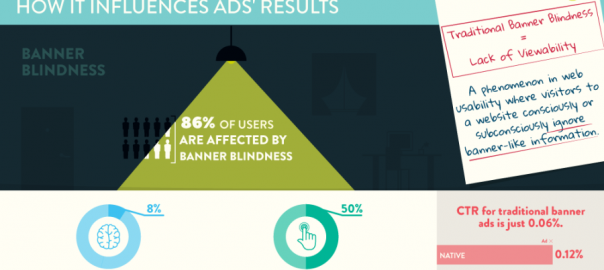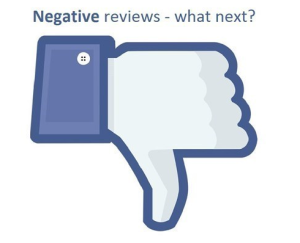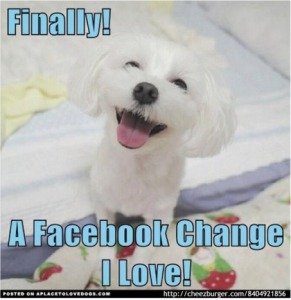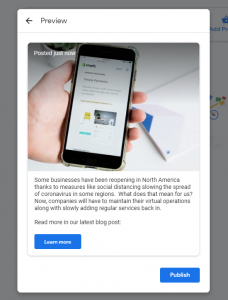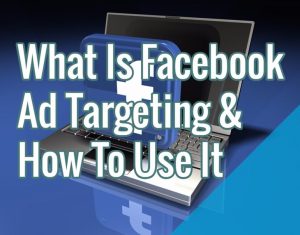Publishers under fire
Ad optimization is a process involving a number of factors that publishers need to pay careful attention to. One of the key challenges facing the display advertising industry is the dual threat of banner blindness and low viewability. These are distinct, although connected, concerns that are increasingly impacting site monetization strategies. At the same time, publishers should also carefully optimize ad placements while paying attention to the overall user experience.
I explore each of these factors that, when optimized, will have a noticeable difference on publishers’ ad monetization strategies in this article. It may seem daunting but keep reading. You’ll be glad you did.
Understanding banner blindness and viewability
Banner blindness
Banner blindness is the name of the phenomenon that developed in recent years where consumers simply don’t see ads on websites because they, effectively, tune them out of their conscious experience of a website. As Nitin Deshdeep put it in his article on the VWO blog titled “Why Banner Blindness Shouldn’t Scare You” –
When web users scan or read through a web page, they only look at information which is relevant to them. They tune out everything else that doesn’t provide them with what they need.
This tendency of users has been developed over time, as the frequency of (irrelevant) ads has grown manifold.
Today, websites are bombarding their visitors with a ridiculous amount of ads. In U.S. alone, over 5.3 trillion display ads were served to users in 2012. This means that a typical web user finds more than 1700 online advertisements every month!
With so many ads constantly encroaching their web space, users have learned to focus just on the information pertinent to them.
The effect of this is that traditional banner ads become visual noise. They’re certainly not the attractive offers that advertisers intend them to be and that consumers may want to engage with.
There is hope, though. Next generation advertising solutions are more resistant to banner blindness and remain effective. One example is in-image advertising which takes advantage of images’ visual prominence on websites. A frequently cited statistic that illustrates the value of placing ads on images comes from Jeff Bullas’ article titled “6 Powerful Reasons Why you Should include Images in your Marketing”:
Articles with images get 94% more total views
Consider what 94% more views can do when paired with ads placed on images which consumers’ attention is naturally drawn to. More views + attention grabbing content = higher CTRs and higher revenue. Simple.
Viewability
Viewability is a measure of whether an ad is visible on a website given common browsing habits. Ads at the bottom of a long page on an isolated page would have a relatively low viewability score and ads at the top of a landing page would have a relatively high viewability score.
Viewability has become increasingly important to advertisers who are concerned that many of the ads placed on websites, which they pay for, are simply not seen by consumers because they are not placed in optimal locations.
The viewability challenge touches on the common metrics publishers and advertisers have used to measure the performance and prices of ads placed on websites.
Advertisers are leading the call for performance metrics to adapt to a viewability-centric monetization model. Fortunately the industry is making progress with a new set of viewability metrics.
What a difference better ad placements and choices can make
Ad placement speaks to viewability but it goes beyond that. An equally important consideration is choice of ad products. There are fascinating trends emerging from research into ad products beyond traditional display ads which point to tremendous benefits from native advertising when compared to traditional display ads.
A report titled “The Rise of Native Ads in Digital News Publications” published by the Tow-Knight Centre for Entrepreneurial Journalism in 2015 highlighted the growing prominence of native advertising formats. There are a few reasons and they largely come down to better integrated and useful formats that add value to consumers.
Whichever ad product publishers opt to use, the message from advertisers is pretty clear: publishers have to ensure that they pay careful attention to ad placements to maximise viewability. The growing consensus among advertisers is that they have been paying for ad impressions, a significant proportion of which are fictitious because consumers didn’t actually see many of the ads paid for.
To a large degree, viewability and ad placement are intricately intertwined and publishers can’t afford to ignore either. Again, this is one of the reasons why ad solutions like in-image advertising are so compelling. In-image ads are typically found in prime locations because they are overlaid on website images and their visual nature makes them highly visible.
Ad blocking is an opportunity to optimize ad revenue
No discussion about online advertising is complete without some consideration of ad blocking and strategies to mitigate its growing effect on the publishing industry. It is a complex discussion, for sure, but there are clear themes that emerge from industry discussions about this troublesome phenomenon.
To begin with, a substantial number of ad blocker users (well over 200 million as at the end of 2015) resort to ad blockers because the user experience on many modern websites is terrible. There are too many ads and, often, those ads present offers that are not relevant to the consumer. Using an ad blocker becomes essential to a decent user experience, even if that means compromising a publisher’s ability to monetize those visits.
Recognizing the incentives to use ad blockers, publishers have adopted a variety of strategies to mitigate the impact on their revenue models. Some publishers, such as Axel Springer in Germany, offer consumers a stark choice: whitelist their sites or find the content they want elsewhere.
Other publishers approach consumers in a more engaging manner and offer an improved ad experience along with a frank explanation of how important ad revenue is to support quality content. Some brave publishers even allow consumers to simply block ads and find alternative monetization strategies to support their businesses.
One of the key lessons emerging from these various approaches is that the user experience is a critical factor (well, perhaps with the exception of publishers like Axel Springer who have a less compromising approach). Improving the user experience is an essential step towards a more effective monetization strategy.
Meeting the ad optimization challenge
Optimizing ad revenue on a site requires a multi-faceted strategy that touches on the themes I have outlined above. In short, this is what publishers should be doing to meet the ad optimization challenge:
- Think of viewability and banner blindness as related challenges and optimize ad placements to make ads more prominent (although without harming the user experience).
- Select ad products based on options that are more optimized for higher viewability; less susceptible to banner blindness and are more engaging for consumers.
- As with your health, prevention is usually better than the cure. In the case of ad blocking, anticipate the triggers that will prompt your consumers to resort to ad blockers and remove them. This means a focus on the user experience, primarily, and proactive engagement with consumers on the topic of how important ad revenue is to producing the great content they expect from you.
Towards more resilient monetization strategies
Challenges facing publishers and advertisers are evolving and becoming more complex. Many publishers perceive threats to their business models but they are really opportunities to build more resilient monetization strategies with more sustainable revenue models.
Certainly, viewability, banner blindness, poor ad placements and ad blocking are negatively impacting publishers’ revenue globally. At the same time, understanding the factors that fuel the industry’s challenges is the path to addressing them more effectively in the new advertising era.
Featured image credit: Pixabay
Digital & Social Articles on Business 2 Community(77)
Report Post